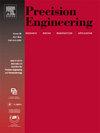振动力平衡机构的寄生动力学研究A频域分析
IF 3.5
2区 工程技术
Q2 ENGINEERING, MANUFACTURING
Precision Engineering-Journal of the International Societies for Precision Engineering and Nanotechnology
Pub Date : 2025-03-03
DOI:10.1016/j.precisioneng.2025.02.019
引用次数: 0
摘要
高速机器人在基本框架上引起振荡的反作用力和力矩,引起破坏性的地面振动和末端执行器精度的损失。在通常的刚性连杆假设下,动平衡可以通过在整个机构中增加质量来消除这些振动力和力矩。在实践中,机器人连杆具有有限的刚度,因此质量的增加可能导致寄生动力学,不希望的振动以及控制器性能和机器人精度的降低。本文论证了这种刚体假设是不充分的,研究了连杆柔度对平衡质量的影响,并与常用的被动隔振方案进行了比较。为了实际说明和验证,对一个简化的平面delta机器人进行了分析。模型和实验均表明,力平衡可使输出振动衰减40 dB/dec。然而,这种效应被限制在该机制的第一寄生特征频率以下的频率范围内。当接近或超过这个频率时,性能会下降。此外,在系统中引入质量会降低特征频率,从而影响机器人的控制器带宽和动态性能。另外,部分平衡解决方案在不损失控制器带宽的情况下实现了80%的振动力减少,为高速机器人不干扰相邻的高精度机械铺平了道路。本文章由计算机程序翻译,如有差异,请以英文原文为准。
The parasitic dynamics of shaking force balanced mechanisms; a frequency domain analysis
High-speed robots cause oscillating reaction forces and moments at the base frame, inducing disruptive ground vibrations and a loss of accuracy at the end-effector. Under the common assumption of rigid links, dynamic balance may eliminate these shaking forces and moments by adding masses throughout the mechanism. In practice, robot links have a finite stiffness, such that the addition of mass may lead to parasitic dynamics, undesired vibrations and a degradation of controller performance and robot accuracy. This paper shows that this rigid body assumption is insufficient and investigates the influence of the link flexibility on the balance quality and compares it to a common passive vibration isolation solution. For practical illustration and validation, the analysis is conducted on a simplified planar delta robot. Both models and experiments indicate that force balancing results in a 40 dB/dec attenuation of exported vibrations. This effect, however, is limited to a frequency range below the first parasitic eigenfrequency of the mechanism. Performance deteriorates close to and beyond this frequency. Furthermore, introducing mass into the system lowers the eigenfrequencies, thereby compromising the robot’s controller bandwidth and dynamic performance. Alternatively, it is demonstrated that a partial balancing solution accomplishes an 80 % shaking force reduction without the loss of controller bandwidth, paving the way for high-speed robots that do not disrupt adjacent high-precision machinery.
求助全文
通过发布文献求助,成功后即可免费获取论文全文。
去求助
来源期刊
CiteScore
7.40
自引率
5.60%
发文量
177
审稿时长
46 days
期刊介绍:
Precision Engineering - Journal of the International Societies for Precision Engineering and Nanotechnology is devoted to the multidisciplinary study and practice of high accuracy engineering, metrology, and manufacturing. The journal takes an integrated approach to all subjects related to research, design, manufacture, performance validation, and application of high precision machines, instruments, and components, including fundamental and applied research and development in manufacturing processes, fabrication technology, and advanced measurement science. The scope includes precision-engineered systems and supporting metrology over the full range of length scales, from atom-based nanotechnology and advanced lithographic technology to large-scale systems, including optical and radio telescopes and macrometrology.

 求助内容:
求助内容: 应助结果提醒方式:
应助结果提醒方式:


